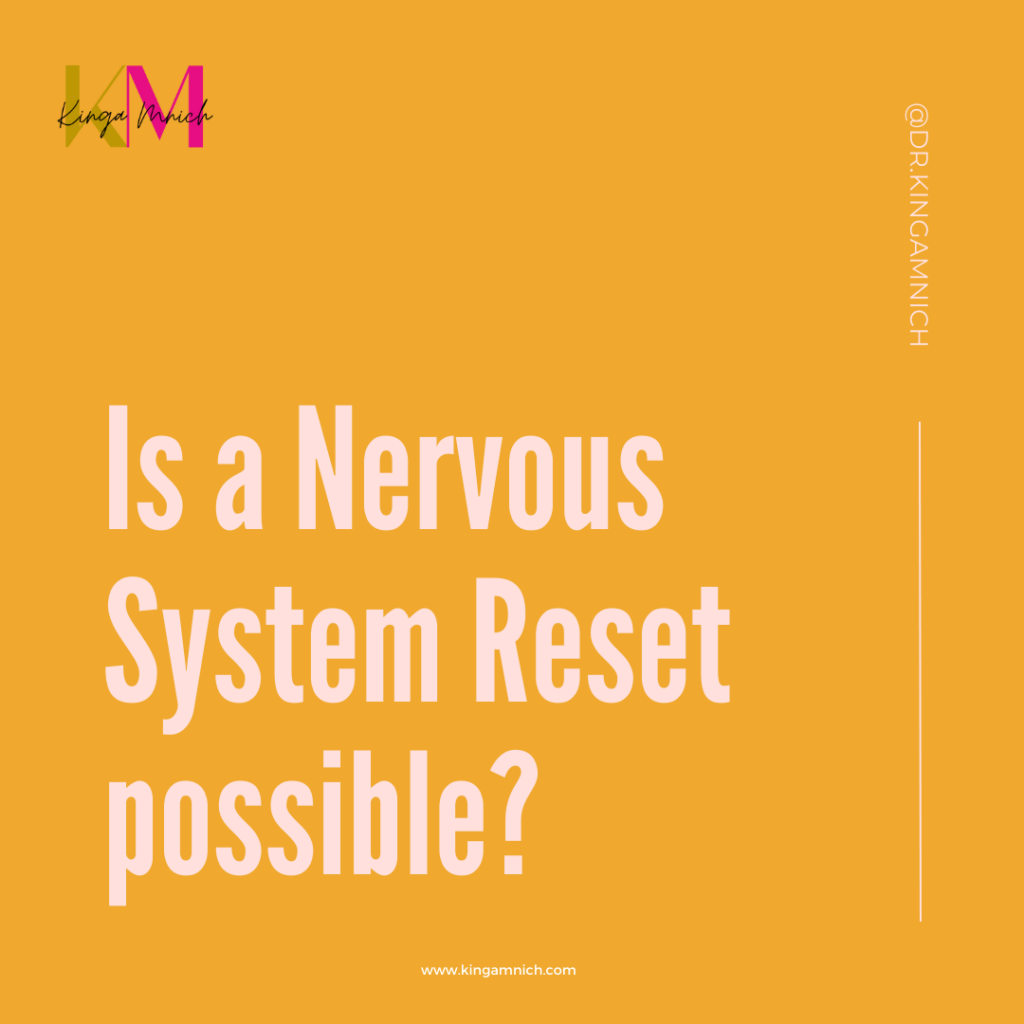The New Trend in Self-Help, Self-Growth Industry
Most of us want a quick fix, a quick win, fast money, less work, more time for ourselves. Right? But, what many of us cannot appreciate, is that our nervous system often burns out in the middle of that chase. And, this chase is getting faster, more demanding, more prolific, because of the marketing and social media that we are exposed to. The marketing works so well! It promises a fast and easy return.
All of this is in contradiction to our brain. In the midst of all this PUSH, our brains want to preserve as much energy as possible.
In opposition to this trend toward constant, even manic hustle, buzzwords such as ‘nervous system reset’ start to appear – likely as an overcorrection. But what does that even mean? A “reset” would mean that there is such a thing as a baseline for your nervous system in the first place. So, anecdotally, it’s as though a 0 would indicate ‘no arousal’ within the nervous system, and 100 would indicate ‘alert! over the top!’.
Table of contents
But that’s not how it works.
Our nervous system always operates. The real question is, which side of your nervous system is currently working?
Let’s start with understanding what the nervous system is.
Understanding the Nervous System: The Body’s Communication Network
The nervous system, an intricate and dynamic network, is the body’s ultimate control and communication system. Imagine it as a complex computing server that is constantly sending and receiving information to keep the body functioning properly (breathing, digesting, moving, sensing, etc.)
Two Main Parts: Central and Peripheral
The Central Nervous System (CNS) comprises the brain and spinal cord. It is our main control center. The brain interprets sensory information, makes decisions, and sends instructions. The spinal cord is like a highway filled with information. It connects the brain to the rest of the body.
The Peripheral Nervous System (PNS) is the network of nerves that spreads throughout the body, connecting the CNS to limbs and organs. The PNS is divided into:
- Somatic Nervous System: Manages voluntary movements like walking or picking up objects.
- Autonomic Nervous System: Controls involuntary actions like heart rate and digestion, further divided into:
- Sympathetic System: Activates the body’s “fight or flight” response.
- Parasympathetic System: Promotes “rest and digest” functions, calming the body after stress.
How Does the Nervous System Work? Neurons and Signals
The nervous system relies on cells known as neurons, which send electrical and chemical messages across synapses, tiny gaps between the neurons. This intricate signaling system enables the body to respond rapidly to stimuli, coordinate its functions, and experience sensations and thoughts.
Regulation and Balance
Nervous system regulation is about maintaining balance (homeostasis) in the body. It’s a continuous process of monitoring and adjusting bodily functions. For example, when you’re cold, the nervous system triggers shivering to generate heat; when stressed, it increases heart rate and breathing for more oxygen supply. Your nervous system is what regulates you.
You see already where I am going with that: How can there be a nervous system reset, if the nervous is what actually resets us?
Great question.
It is not possible to reset our nervous system. But it is possible to regulate it. It is advisable to regulate in the world we live in today.
Of course, there are scenarios where it becomes difficult for the self-regulating system to operate properly. PTSD is one of the most common mental health conditions that leads to persistent anxiety, fear, and traumatic memories that trigger the fear or flight response without the actual experience of danger.
PTSD Nervous System Regulation
Post-Traumatic Stress Disorder (PTSD) can develop as a result of experiencing or witnessing a very stressful, or terrifying event, such as physical abuse, war, violent encounter, dramatic illness, or physical abuse. Witnessing situations that trigger the fight, flight, freeze response can profoundly affect the nervous system, keeping it in a heightened state. That is when these so-called nervous system reset programs come in.
When experiencing PTSD symptoms, the nervous system stays in a heightened state of stress. The sympathetic nervous system, responsible for the “fight or flight” response, becomes overactive, making individuals with PTSD constantly feel on edge and unable to relax.
Conversely, the parasympathetic nervous system, which calms the body after stress, may underperform, making it difficult to return to a calm state. As previously pointed out, our nervous system functions like a balancing scale. It regulates the needs of our body. When a person experiences PTSD it is not enough to lower the involuntary fear or flight physiological changes in the body and mind. It is necessary to encourage and enable the rest and relax state of a person so they can remember how it feels and engage actively in techniques that help them to use the tools to regulate their responses when triggered.
Post Traumatic Growth
It is also important to mention that not everyone experiences PTSD after a traumatic experience. Many experience Post Traumatic Growth.
Much of regulating your nervous system is based on building resilience, which is a result of overcoming adversity and other challenges, which can lead to a higher level of functioning.
According to Dell’Osso et al. 2022 “PTG may feature positive changes in self-perception, interpersonal relationships and philosophy of life, leading to increased self-awareness and self-confidence, a more open attitude towards others, a greater appreciation of life and the discovery of new possibilities.”
Therefore, PGT is not an alternative, but rather a parallel process, to PTSD, as Martine Seligman showed in his work. It’s a process that a person can choose to focus on.
For some people, this might not be accessible right away, and professional help is needed. However, here are some techniques that can help regulate the nervous system.
Techniques to Regulate Your Nervous System
Some of these common techniques for regulating the nervous system in PTSD include mindfulness and relaxation exercises to promote parasympathetic activity, cognitive-behavioral therapy to process and reframe traumatic memories, Eye Movement Desensitization and Reprocessing (EMDR) to help the brain process trauma. Additionally, somatic experiences which focus on bodily sensations, help to release pent-up trauma.
According to Amanda Baker Somatic therapy focuses “on the body and how emotions appear within the body,” Baker explains. “Somatic therapies posit that our body holds and expresses experiences and emotions, and traumatic events or unresolved emotional issues can become ‘trapped’ inside.”
These techniques aim to restore balance to the nervous system, helping to manage symptoms and improve quality of life. It is important to remember that different therapy tools work for different people. No approach fits all. Any therapist or coach who makes a statement like that should be approached with caution.
Another treatment in combating PTSD is the use of psychedelics, which can be administered in micro-dosing and macro-dosing. Both should be administered under professional guidance.
Key Takeaway
The nervous system is essential for our survival and well-being. It not only enables us to interact with the world but also meticulously regulates our internal environment, ensuring that our body operates smoothly and efficiently. There is no baseline to which we can bring back our nervous system. It is all about regulating through awareness, tools, and even professional help.
Additional Resources:
Podcast Episode: On Air With Ella: Microdosing Therapy: the Benefits of Plant Medicine, Psychedelics, Psilocybin + More with Neurologist Dr. Maya Shetreat
Article:
American Psychiatric Association. (2013). Diagnostic and Statistical Manual of Mental Disorders (5th ed.). Arlington, VA: American Psychiatric Publishing. – This manual provides the formal criteria for diagnosing PTSD and an overview of its symptoms.
van der Kolk, B. (2014). The Body Keeps the Score: Brain, Mind, and Body in the Healing of Trauma. New York: Viking. – This book offers an in-depth exploration of how trauma affects the body and the nervous system and discusses various innovative treatment methods.
Shapiro, F. (2018). Eye Movement Desensitization and Reprocessing (EMDR) Therapy, Third Edition: Basic Principles, Protocols, and Procedures. New York: Guilford Press. – This text outlines the theory and practice of EMDR, a treatment for PTSD.
Books:
The Body Keeps the Score by Bessel van der Kolk M.D.
Book Summary:
“The Body Keeps the Score: Brain, Mind, and Body in the Healing of Trauma” by Bessel van der Kolk is a seminal work in understanding trauma and its treatment. Here’s a summary:
Overview:
The book delves into the nature and impact of trauma on the mind and body. Van der Kolk, a renowned trauma expert, draws on decades of research and clinical experience to explain how traumatic experiences physically reshape the brain and body, affecting an individual’s feelings, thoughts, and capacity for joy and engagement.
Key Concepts:
- Trauma’s Impact on the Brain: Van der Kolk explains how trauma can alter the brain’s structure and function, particularly areas involved in processing danger and emotion. These changes can lead to difficulties in managing emotions, memory problems, and increased anxiety.
- The Body’s Memory: Van der Kolk emphasizes that trauma is not just psychologically damaging but also leaves a physical imprint on the body. Traumatic memories are stored not just in the brain but also in the body, manifesting as physical symptoms like chronic pain or tension.
- Limitations of Traditional Talk Therapy: The book critiques traditional talk therapy approaches for treating trauma, arguing that they often fall short because they neglect the physical and sensory experiences of trauma survivors.
- Holistic and Innovative Approaches: Van der Kolk advocates for more holistic and body-centered therapies. These include yoga, EMDR (Eye Movement Desensitization and Reprocessing), neurofeedback, and mindfulness, which help in re-establishing a sense of safety and reconnection with the body.
- Importance of Relationships and Safety: The book stresses the importance of safe, nurturing relationships for healing from trauma. It suggests that establishing safety and rebuilding trust are critical initial steps in the therapeutic process.
- Empowerment and Self-Awareness: Van der Kolk encourages trauma survivors to develop self-awareness and self-regulation skills. He emphasizes the empowerment of survivors in their healing journey, moving from being stuck in the past to leading a more present and fulfilled life.
Conclusion:
“The Body Keeps the Score” offers a compassionate and comprehensive look at trauma, its effects on the body and brain, and innovative approaches to healing. It’s a valuable resource for trauma survivors, therapists, and anyone interested in understanding and treating traumatic stress.












